Whatever Shall I Wear to the Ball?
Suggestions for Assembling an 1858 CostumeFollowing are my own personal suggestions on dressing a lady for the 1858 Ball and other events as part of Freeport's celebration of the 150th Anniversary of the Lincoln-Douglas Debate to be held on Labor Day Weekend, 2008. The information is based on my own experience with over twenty years of 19th century historical costuming and research.
For each item I've included three sections: authentic pattern information to make it yourself, sources to buy it ready-made, and suggestions on how to cheat. Keep in mind that how authentic you dress is entirely up to you. If you plan to continue participating in historic dancing or reenactments then you should make each layer as authentic as possible (or plan to "upgrade” layers later), but if you’re not likely to don your 1858 outfit again until the 200th Anniversary in 2058 then it is perfectly acceptable to cheat on as many layers as possible – and even skip some under-layers altogether. Corset
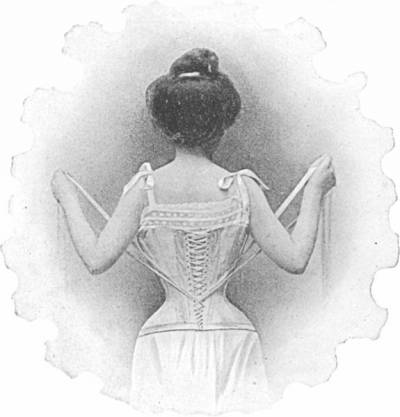
The super-tiny wasp-waisted look was popular much later in the century. This photograph is from 1905 - almost 50 years later. You do not have to look like this for the 1858 ball!
Two of the most common misconceptions about corsets are that (1) Their sole purpose was to make the wearer have a tiny waist and (2) They are ungodly uncomfortable. The truth is neither is true.
The beginnings of the brassiere began in the early 1900s. Since bras weren't invented yet in 1858, one of the primary purposes of the corset is to support the bust. You wouldn't be comfortable doing aerobics without a bra, and our ancestors wouldn't have been comfortable dancing, playing croquet, or riding in a carriage down a bumpy dirt road without their corsets to support them.
The corset also raises the bust. Your modern bra places the breasts right about in their natural position, but throughout most of history fashion has dictated that the bust be much higher. The top edge of your 1850s corset should be about halfway across the breast, right at the nipple (although I find it is more comfortable when the top of the corset is just a tad above the nipple). This flattens the lower part while pushing everything up higher, giving the illusion that your breasts are much higher than they naturally sit.
Your 1850s corset will smooth your midsection, eliminating any pouch or belly rolls you may have, but not necessarily reduce the waist. The crazy wasp-waisted look didn't come into vogue until the 1880s and 1890s - so you are spared trying to achieve that look!
The corset also makes you exactly the same size every day. We all know that women retain water throughout their monthly cycle - jeans that don't fit today will work just fine next week. The bodice-clinging dresses of the Victorian era required that your body be exactly the same size every day - a feat that is only possible while corseted.
And finally a word on comfort. If you truly can't breathe then your corset is too small, or laced too tightly, and you will be uncomfortable. A properly fitting corset feels tight - but not uncomfortably so. A good corset will support your back, similar to a weight-lifting belt. Although you will not be able to bend at the waist, you can bend at the hips just fine, which is better for your back anyway.
To Make Your Own: Corsets are difficult and allow absolutely no "fudge" room, so should only be attempted by accomplished seamstresses. In addition, you will need a seamstress-friend to help you with the fitting and adjusting - it simply can not be done alone.
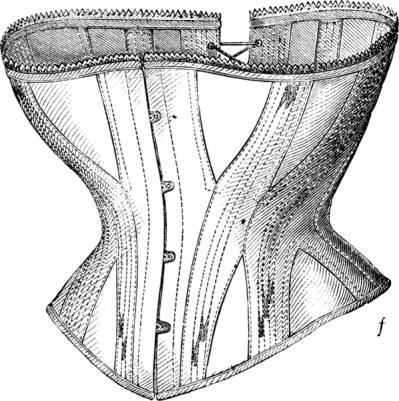
Corset advertised in Harpers Bezar in 1869. It is very similar to the PastPattern 708 pattern.
PastPatterns (www.pastpatterns.com) pattern number 705 offers three different styles of early to mid-19th century stays. All three are very lightly boned (the rigid metal inserts are called "bones" or "stays"), which some find more comfortable. Number 703 is dated 1863 but will still work for 1858. It is called a "skirt supporting corset" because a metal band in the back lifts the skirt, easing some of the weight of your petticoats off your waist. Number 708 is dated 1840s to 1870s. Gussets at the bust and hip make it easy to size and adjust. I made a 708 and wore it for many years.
For most PastPattern corsets you have the option of buying just the pattern or the kit, which includes a sturdy corset fabric plus whatever eyelets, busk (front closure), or stays (metal strips to keep it rigid) that are needed to complete the pattern. I recommend buying the full kit.
Locally, you can buy Simplicity patterns 2890 or 9769, both offer a chemise, drawers and corset. Simplicity pattern 7215 offers a chemise and a corset, and Simplicity pattern 5726 has a chemise, corset and petticoat. All are available at Jo-Anne Fabrics in Freeport.
Tip: When purchasing fabric for your corset make sure it is a very sturdy fabric. A thin cotton will rip apart the first time you wear it. A heavy cotton canvas is best.
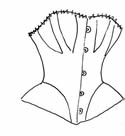
This is the "E62 Victoria Corset" designed by Kay Gnagey from a pattern published in La Mode Illustree in January 1862. This is the corset I wear.
To Buy a Historic Reproduction: In my opinion, the best custom corset maker is Kay Gnagey of Originals by Kay at www.originals-by-kay.com. Her corsets cost between $95 and $120 and can take two to three months from the date of order, depending on the size and style, but they truly are the best. My current corset is from Originals by Kay and I've been very pleased with it. Even if you don't buy from her, it is worth your while to look at her website for some excellent research on mid-19th century corsets.
Abraham's Lady in Gettysburg (www.abrahamslady.com) also sells custom corsets. I have not purchased corsets from her, but judging by the quality of other items I have purchased I believe it would be a quality product. Her corsets cost $95.
$IMAGE4$
The Little Hugs corset over the Little Hugs chemise.
Locally you can buy a ready-made corset from Little Hugs of Freeport on her website at www.reenactmentcostumes.com. The Little Hugs corset laces both in front and back, which makes it easy to adjust - and to dress yourself! The Little Hugs corset will cost about $80, and you can ask to pick it up in Freeport in order to save yourself the shipping charges.
To Buy a Modern Corset: The most important qualities of a corset is that it fit comfortable and give the proper shape. A modern corset will be made from modern materials, and may even include zippers or velcro (neither of which were invented yet in 1858), but the advantage is that a modern corset will cost less and will be faster. Buy a local modern corset and you can take it home immediately, or buy a catalog modern corset and you only have to wait a few days for the shipping time.
Additionally, most modern corsets can be thrown in the washing machine without worrying about shrinking or rusting. Authentic reproduction corsets should be rarely washed. Your chemise will keep your corset clean, however if you wear a modern corset then you can skip the chemise and wash your sweaty corset the next day.
Locally you can purchase a modern corset from Lavender 'n' Lace. The 6709 Empire Intimates is the proper shape. It laces in the back and has hooks and eyes in the front. It comes in sizes 34 to 48, and you can try it on in the store to make sure you like the fit. The 6709 costs between $50 and $60. (Note: The manufacturer calls it an Edwardian corset but it is actually a Victorian style).
Beware of the other corsets at Lavender 'n' Lace. They are all temptingly beautiful, but most are merely decorative and are too flimsy to provide the support you'll need for a full night of dancing.
Fredericks of Hollywood (www.fredericks.com) has an impressive selection of modern corsets. The Hollywood Dream Corset (Item 51786) has the proper 1850s shape and comes in a variety of colors for $60. The Renaissance Corset (Item 50640) for $64 is also the proper shape, but it has straps so can not be worn under an open-neck ballgown. Be careful to buy a substantial corset. Many of Fredericks corsets are too flimsy to provide the support you need to dance.
A Tip: Original sources state that white was the most ladylike and proper corset color, however surviving originals from the era are in just about every color imaginable, even patterned fabric! White is the most traditional color, but feel free to wear any color you choose - just don't wear a dark corset under a light colored dress!
Another Tip: After tying your corset in the back, loosely wrap the excess cord around your waist and loosely tie it. Don't cut the excess, or you may not be able to tie it next time, and leaving the extra cord hanging down your back and brushing against the back of your legs will drive you crazy!
Hoops and Petticoats
First, a little bit of history on hoops and petticoats.
In the 1810s the style was a very straight skirt. Petticoats (a full length under skirt worn under the dress skirt, what we would today call a slip) were worn, but were strictly for modesty and were not intended to give the dress any volume.
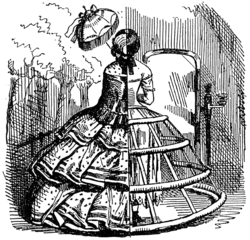
Illustration of the cage crinoline from the magazine Punch in August, 1856.
In the 1820s and 1830s dresses had a fuller look. The skirt was given more volume by wearing multiple petticoats, or by adding corded petticoats. A corded petticoat is a petticoat with channels sewn into it just above the hem, with heavy cords (think of cotton laundry line) pulled through. The cording gave the skirt some flair, but was still very flexible.
In the 1840s skirts became even fuller, with more petticoats, flounced petticoats (petticoats with rows of ruffles), starched petticoats (petticoats soaked in starch and water, hung to dry and then ironed to make them extremely stiff) and corded petticoats. But there was a downside - wearing multiple petticoats makes it very difficult to walk or dance.
That changed in the 1850s with the invention of the cage crinoline (hoop skirt). The cage crinoline looks like a bird cage, with horizontal wire hoops held in place by vertical strips of fabric. Throughout the 1850s new patents improved upon the design, and soon women of all classes were wearing some version of hoops.
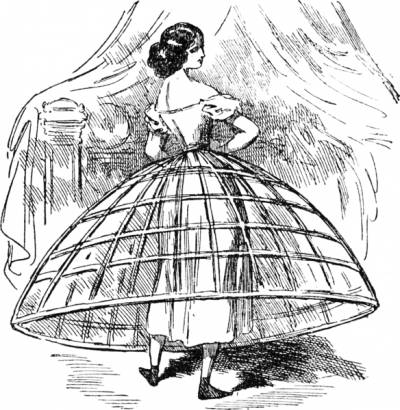
A five bone (each row is called a bone) cage crinoline worn over a modesty petticoat or a long chemise. (From the Karikatur-Album by C.E. Jensen, MDCCCCVI, Page 504)
The cage crinoline was a wonderful invention. Women could move their legs freely - so much that some wondered if the new fashion was giving women too much freedom! The airy cage hoop is much cooler on a hot summer day than wearing layers and layers of petticoats, and a hoop with one petticoat weighs less than multiple petticoats, so women had much less weight to carry around.
There were disadvantages, too. On a windy day a cage crinoline will blow around, immodestly exposing the legs, and if a woman falls for any reason the hoop will hold her skirts up in the air for all the world to see. The stiff hoops make it difficult to climb into a carriage, and require that only one woman pass through a doorway at a time. Humor magazines of the day made fun of the style and the embarrassment it sometimes caused.
A modesty petticoat (an uncorded, unstarched mid-calf petticoat) is worn under the cage to hide your legs, and an over-the-hoop petticoat (also uncorded and unstarched) is worn over the cage to give your dress a smooth look (otherwise your dress will look lumpy from the bones). Another option is to wear a flounced hoop skirt, the ruffles will hide the ridges of the hoop and you can skip the over-the-hoop petticoat.
A Tip: Practice sitting in your hoop. Once you master sitting, everything else is easy. In a modern skirt most women run their hand along their backside as they sit. This keeps your skirt straight and smooth, reducing wrinkles. In your hoop skirt you want exactly the opposite effect. As you sit, lift your skirt slightly so that the fabric is bunched up around your backside. Sitting on a smooth, wrinkleless hoop will cause it to pop up in the air, but sitting on a gathered, wrinkled hoop will cause it to limply lay on the ground, enclosing you in a circle of fabric, ruffles and lace - exactly the effect you want!
Hoop Skirts and Cage Crinolines
To Make Your Own: For a cage crinoline, Originals by Kay makes a kit that includes materials and instructions to make your own seven bone (each row is called a bone) cage crinoline in a 90 or 108 inch circumference for $65. It doesn't take any sewing skill, but it does help if you're a bit handy.
PastPatterns (www.pastpatterns.com) pattern number 712 is a fabric hoop skirt with boning sewn in. It can be ordered as a kit or just the pattern alone.
Locally, you can buy Simplicity pattern 9764, a fabric hoop skirt with boning sewn in, at Jo-Anne Fabrics in Freeport.
A Tip: If you make your own hoop, I recommend buying a kit. The heavy boning you need is hard to find (I haven't bought any in years). The lightweight plastic boning found in modern fabric stores is too light and you'll find the boning wants to curl in the wrong direction.
To Buy a Historic Reproduction: Locally you can buy a ready-made hoop skirt from Little Hugs of Freeport on her website at www.reenactmentcostumes.com. The Little Hugs hoop skirt is a fabric petticoat with two or three bones in a 90, 110 or 120 inch circumference. They cost about $50, and you can ask to pick it up in Freeport in order to save yourself the shipping charges. (Note that the website calls them "rings," not "bones," but it's the same thing.)
Also locally, you can purchase hoops at Lavender 'n' Lace in Freeport. They have three and four bone hoop skirts for $35 to $40, all with a drawstring waist.
The four bone, 110 inch circumference hoop skirt from Abraham's Lady, worn over a chemise.
Abraham's Lady in Gettysburg (www.abrahamslady.com) sells four bone fabric hoops in 90, 110 and 120 inch circumference, and a six bone 135 inch circumference hoop. Her 110 inch hoop comes plain or flounced (with ruffles). They cost between $40 and $60.
To Cheat: First, look in the far back corner of your own closet for prom and wedding slips. If you don't have a hoop slip, you may have a heavily ruffled slip that will give the appearance of a corded or starched petticoat. Be sure to check the closets of friends and relatives - you'd be surprised at how many people have prom and wedding slips tucked away.
Locally you can purchase crinoline slips from Lavender 'n' Lace. Their crinolines have multiple layers of crisp net ruffle sandwiched between a fabric layer on top and bottom and come in a variety of styles of poofiness. They come with a drawstring waist and depending on the style will cost between $45 and $65.
A Tip: If you're using a modern crinoline slip with net ruffles, make sure the net does NOT touch your skin - it is horribly itchy and will drive you crazy! Most skirts will have net ruffles layered between a fabric underskirt and overskirt. If not, make sure you wear a slip underneath.
Petticoats
To Make Your Own: PastPatterns (www.pastpatterns.com) pattern number 706 includes drawers and a petticoat.
Simplicity pattern 5726 has a chemise, corset and petticoat, available at Jo-Anne Fabrics in Freeport.
If you're comfortable winging it, use your dress skirt pattern to make a petticoat. Use the same panels as the skirt, and you can design your petticoat with either a waistband or a drawstring waist.
Or, don't use a pattern at all. Using four or five yards of fabric, sew the ends to create a tube, leaving about ten or twelve inches at the top to create a split. Gather it into a waist band or hem a draw-string casing at the top, then hem the bottom edge. You can leave the bottom edge plain, add some lace, or attach a ruffle (which will also add extra volume).
To Buy a Historic Reproduction: Locally you can buy a ready-made petticoat from Little Hugs of Freeport on her website at www.reenactmentcostumes.com. The Little Hugs petticoat is 100% cotton and has a nice 4 inch ruffle at the bottom to add extra volume. They cost about $35, and you can ask to pick it up in Freeport in order to save yourself the shipping charges. (Note that the website calls them slips, not petticoats, but it is the same thing).
Abraham's Lady in Gettysburg (www.abrahamslady.com) sells a petticoat made from three yards of fabric (she calls it an underslip) and a petticoat made of five yards of fabric (which she calls an overslip) for $30 to $35. The three-yard petticoat will work as a modesty petticoat and the five-yard petticoat is an over-the-hoop petticoat. If you're not wearing a hoop then either one would work.
To Cheat: Any modern slip or even a modern full skirt will serve the same purpose as a petticoat.
A Tip: Note of the circumference of your hoop, and make sure your petticoat and dress are both larger in circumference along the bottom hem than the hoop. If they are too close in size your dress will be stretched out over your hoop and you'll look like you're wearing a lamp shade. The larger your dress circumference is in comparison to the hoop circumference, the more gracefully your dress will hang.
A Note: I am well aware that Mammy wore a red silk starched petticoat in Gone With the Wind, but every surviving original petticoat I have ever seen has been white. If they were worn in any other color I have not seen it. Wear white and you can't go wrong.
The Dress
Off-the-shoulder ball gowns in a rainbow of colors. The Empress Eugenie Surrounded by her Ladies in Waiting by Franz Winterhalter, painted in 1855.
Far more important than any of your underwear is the outer dress itself.
A lot of your dress will depend on your own personal taste, but there are some basics of the 1858 style. Your dress should be long, about four inches above the floor. The neckline is open and off-the-shoulder for evening, and to the neck (but not a high neck) for daytime.
Your bodice (the top of the dress) and skirt should be the same color and fabric so that they look like one garment, although they are usually sewn as two separate pieces.
A Tip: I sew the bodice and skirt as two separate pieces, then attach hooks and eyes so the bodice and skirt can be fastened together. Otherwise I find my underpinnings stick out of my belly every time I raise my arms!
To Make Your Own:
PastPattern's style 704 Ballgown bodice. I made the one on the left using green fabric and black lace - very pretty.
PastPatterns (www.pastpatterns.com) pattern number 704 is a ballgown bodice.
Patterns 701, 702, and 801 are all day bodices. I wear the 702 bodice. It is a very form-fitting bodice, without any fudge room. I've made it with the modified pagoda sleeves as the pattern directs, and have also made it with my own coat sleeves (a narrower style of sleeve).
(My 702 with coat sleeves is currently on display at the Freeport / Stephenson County Visitors Center 1858 Expo. It is the blue plaid standing in front of the shinny carriage).
The gathered bodice from pattern 701 is a looser bodice, and
the 801 bodice is a loose fan-front bodice over a form fitted lining. If you're a beginner seamstress, or if you plan to wear your bodice without a corset, the looser bodice would be a better choice.
Skirt patterns 700 and 800 work for day or evening.
PastPattern number 803 is what we would today call a "prairie style" dress. It is a common dress for a farmer's wife or working class woman and not intended to be worn with a hoop. If you're not one for a lot of flamboyance, you can wear this simple dress (without a hoop) to the 1858 ball.
1858 fashion plate of day dress from Le Journal de Demoiselles.
Simplicity pattern 2887, 2960, 3727 and 3791 are all day dresses. Pattern 2881 is a ballgown. All are available at Jo-Anne Fabrics in Freeport.
To Buy a Historic Reproduction: Locally you can buy a ready-made "basic dress" from Little Hugs of Freeport on her website at www.reenactmentcostumes.com. Prices range from $80 to $150.
The Abraham's Lady in Gettysburg (www.abrahamslady.com) style labeled "1860s Day Dress" ($135) is lined with a fitted bodice and bishop sleeves. The skirt has five yards of fabric, which will drape nicely over a hoop.
She also has a "Two Piece Garibaldi Set" ($115). The Garibaldi style bodice is unlined and is a looser, unfitted style. A good choice if you are uncomfortable with a fitted bodice, or if you don't plan on wearing a corset. The skirt also has a full five yards of fabric. Custom orders take about four weeks, or you can call to see what she has available in her store that could be shipped out immediately.
Источник: http://www.suzybeggin.com/1858%20Clothing.htm |





